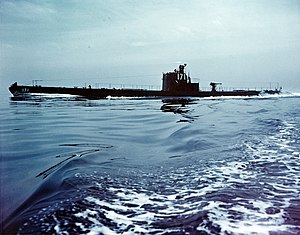USS Cuttlefish (SS-171)
 |
|
| History | |
|---|---|
|
|
|
| Name: | USS Cuttlefish |
| Builder: | Electric Boat Company, Groton, Connecticut |
| Laid down: | 7 October 1931 |
| Launched: | 21 November 1933 |
| Commissioned: | 8 June 1934 |
| Decommissioned: | 24 October 1945 |
| Struck: | 3 July 1946 |
| Fate: | Sold for breaking up, 12 February 1947 |
| General characteristics | |
| Class and type: | V-8 (Cachalot)-class direct-drive diesel and electric submarine |
| Displacement: | 1,130 tons (1,150 t) surfaced, standard, 1,650 tons (1,680 t) submerged |
| Length: | 274 ft (83.5 m) |
| Beam: | 24 ft 9 in (7.54 m) |
| Draft: | 16 ft 3 in (4.95 m) maximum |
| Propulsion: |
|
| Speed: | 17 kn (31 km/h) surfaced; 8 kn (15 km/h) submerged |
| Range: | 6,000 nmi (11,000 km) @ 10 kn (19 km/h), 14,000 nmi (26,000 km) @ 10 kn with fuel in main ballast tanks, 83,290 US gal (315,300 L) oil fuel |
| Endurance: | 10 hours at 5 knots (9 km/h) |
| Test depth: | 250 ft (80 m) |
| Complement: | 6 officers, 39 men (peacetime); 7 officers, 48 men (war) |
| Armament: |
|
USS Cuttlefish (SC-5/SS-171), a Cachalot-class submarine and one of the "V-boats," was the second ship of the United States Navy to be named for the cuttlefish. Her keel was laid down by Electric Boat Company in Groton, Connecticut. She was launched on 21 November 1933 sponsored by Mrs. B. S. Bullard, and commissioned on 8 June 1934, Lieutenant Commander Charles W. "Gin" Styer in command. Cuttlefish was the first submarine built entirely at Electric Boat's facility in Groton, Connecticut; construction of previous Electric Boat designs had been subcontracted to other shipyards, notably Fore River Shipbuilding of Quincy, Massachusetts. Four Peruvian R-class submarines had previously been finished in Groton, using material from cancelled S-boats salvaged from Fore River.
Cuttlefish differed from her sister Cachalot (built by the Portsmouth Navy Yard) mainly in her innovative welded (replacing the previous riveted) construction. Wartime experience would later prove that welding was a sound technique. Both were medium-sized submarines built under the tonnage limits of the London Naval Treaty of 1930. An extensive study was conducted to determine the optimum submarine size under the treaty restrictions, factoring in total force, endurance, and percentage of the force that could be maintained on station far from a base, as in a Pacific war scenario. Despite the calculation process, size reduction had gone too far with the Cachalots, limiting their patrol endurance. After three Pacific war patrols, Cuttlefish was relegated to training duties in September 1942, once numerous Gato-class boats became available.
...
Wikipedia
